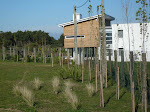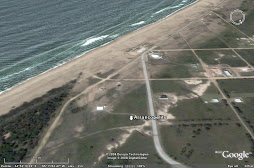I find myself in constant need of explaining Punta del Este to audiences who seem to not get it.
One of the things that the growing number of expats colonizing Montevideo and Piriapolis seem to rail against is the “Miami” Punta, the stretch of gaudy high-rises abundant in wrought iron, crystal chandeliers, or Luis Whatever furniture in the lobby. Well, newsflash, that is not my Punta del Este, or the Punta del Este of most of my friends, acquaintances, and even of most of my clients. (I do have some customers in the Miami Punta though.)
The Punta del Este we think of as ours is a place of casual, low key esthetics, where luxury is expressed in terms of views (sea, dunes, forests, gardens) and sounds (waves crashing, birds singing) and where nature also informs design and decor. Hardwood versus shiny brass and crystal.
 Pool at Pinar del Faro
Pool at Pinar del FaroIn the interior design business in Punta del Este it is customary to have new development model units furnished by local design shops, and needless to say, the competition is fierce for the privilege of planting a conspicuous sign on the road that says “Decorated by...” Sometimes the building is not yet a hole in the ground, and the developers are pestered by furniture shops wanting to lock in the so called “showroom” (model unit in Spanish is “showroom”, go figure).
In that mad race, I always find myself saying “screw them, we don´t need the hassle” against my Mom´s view that “everything helps.” After many years of doing this, my conclusion is that it only helps when there is a true meeting of the minds with the developers and designers of the project in question, and that otherwise the costs outweigh the benefits of brand exposure.
 Fountain at Pinar del Faro
Fountain at Pinar del FaroHowever, when we do find these business “soul-mates,” the benefits keep piling up (I´m trying to avoid using the dreaded s....y word ). I have come to think of it this way, “If our shop were a building, would it look like this?” If the answer is “No way” or “That´s too small” or “Never in that exterior color,” then we should not be furnishing the model unit. But when we find a project where we would want to buy property, then the stars are fully aligned. In the past couple of years we have found a couple of those that are currently on the market, and a couple in earlier stages at this point.
One is Brava 28 (http://www.brava28.com), a low-key, sober looking condominium building in the Rincon del Indio area where –regardless of whether or not we end up buying a unit-- the entire project is something we are proud to be connected to. A two-block, L-shaped building with four-floors in each block, Brava is luxurious in its comfort (large floor plans where every room is generous in size and holds ample storage space), in its views and its finishes, without being cheesy or flashy. A huge pool protected from the winds by both blocks and by a grass-covered dune is surrounded by wooden decking. The landscaped grounds surround the building on every side, and the finishes include lots of slate, hardwood and white. The sea can be seen beyond the dunes with their characteristic native bush, and the forest and neighborhood landscaped yards are usually visible from bedrooms or kitchens. We´re already on our second model unit furnished in Brava, as the first one sold, and we have had several clients among the buyers.
Another, newer project where we are completing the model house furnishing is a gated community in José Ignacio called Pinar del Faro. For those with some understanding of the local scene, this is a very chic project, starting with its location, on the highway at the entrance of José Ignacio town, to the pedigree of its developers, Argentine heavyweights Nordelcor, and, as importantly, designed from the master plan to the decoration of the model house by locally renowned architect Mario Connio. If Connio signifies anything in Punta del Este, it is the polar opposite of the “Miami Punta” esthetic. His shack-on-the-dunes style invariably includes thatched roofs, a local classic that has been practically abandoned by the Uruguayan middle class and is being revived by the hipper-than-thou Connio.
Pinar del Faro is comprised of about 250 lots in 40 hectares, with lots of pines, palms, a lake, two huge pools (the one for children or families FAR AWAY from the one for grown-ups) two plazas, tennis courts, a restaurant, club house, etc., plus underground utility connections and Internet access (I have no idea how good or what system). Lots range from 1000m2 (quarter acre) to around a half acre for the largest ones. They are not third-world cheap, but hey, this is a place where I would not mind living year-round, or just having a lot “for the future.”
The multiple sets of regulations include a building plan approval requirement that involves an architectural firm engaged for policing the Connio shabby-chic-by-the-ocean style. Fine by me, as I would not want any cheesy McMansion ruining my morning walk or any fake “Colonial” (what in Spain they call “Romantic” and what in the U.S. they call “Spanish”) style home interrupting my digestion.
 Lake at Pinar del Faro
Lake at Pinar del Faro
So luxury for me, the height of material decadence, is a combination of comfort (from Internet access, to a bathroom roomy enough to avoid bruising, a real spa-grade Jacuzzi, vs. glorified bathtub), and a certain combination of materials and elements that include lots of wood, greenery and absence of man-made noises. A rustic sort of luxury. So we look for these kinds of developments that truly reflect the essence of Punta del Este´s style, that make us start thinking about purchasing property while we plan the decoration of the model unit, and where the general feeling is more laid back California than tarted up Miami.



No comments:
Post a Comment